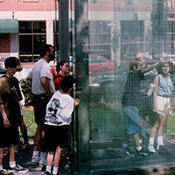 The question “Who is a Jew?” is complicated in the United States. Traditionally, Jewish identity was determined by matrilineal religious commitments. However, the major Jewish denominations vary in whom they consider Jewish. Even further, new Jewish movements like Jewish Renewal and Jews for Jesus have expanded and complicated the definition of Judaism itself.
The question “Who is a Jew?” is complicated in the United States. Traditionally, Jewish identity was determined by matrilineal religious commitments. However, the major Jewish denominations vary in whom they consider Jewish. Even further, new Jewish movements like Jewish Renewal and Jews for Jesus have expanded and complicated the definition of Judaism itself.
The openness of American society and the process of assimilation have served to diversify the Jewish community, even to the point of clouding the definition of who is a Jew. For this reason, it is difficult to count the number of Jews in America, as it is increasingly difficult to determine who should be counted. In the process of assimilation, some make a complete break from the Jewish community and no longer call themselves Jews. At most they may consider themselves “of Jewish descent.” Should these individuals be counted as Jews despite their own preference?
Intermarriage, the symptom of assimilation, further complicates matters. The phenomenon has created a new category for pollsters: people who live in households in which one of the marriage partners is Jewish. This is a meaningful category insofar as many non-Jewish spouses of Jews participate in some form of Jewish living, though they do not to convert to Judaism. Those who do convert constitute yet another category: many would call themselves “Jews by choice.” But their children create perhaps the most perplexing issue.
According to traditional Jewish law, a Jew is one born of a Jewish mother. Thus, the child of a Jewish mother and a non-Jewish father is automatically considered a Jew. But the child of a Jewish father and a non-Jewish mother is not. In 1983, in response to the rising number of such “half-Jewish non-Jews,” the Reform movement of American Judaism decided to change Jewish law to include both the children of a Jewish mother and a Jewish father in determining who is a Jew. The other branches of American Judaism have not followed suit, however, and the issue has only become further entangled.
Orthodox Jews reject such a reinterpretation of Jewish law altogether. Following the Reform decision, one Orthodox rabbi raised the startling question, “Will there be one Jewish people by the year 2000?” Prior to the modern period, all Jews were united by Jewish religious law. While modernity brought greater diversity, until 1983 even the most liberal Jews still subscribed to traditional standards in matters of marriage and personal identity. The break with these standards seemed to traditionalists to threaten the future unity of the Jewish people.
A more immediate problem is the growing animosity between Jews that has resulted from the widening spectrum of religious expression—again, the consequence of an open society. The issue of matrilineal versus patrilineal descent is only one of the dividing lines within American Judaism today. Other such contentious issues are the rabbinic ordination of women, the religious status of homosexuals, the form of synagogue worship, and the authority of Jewish law. On these and other issues Jews disagree. In terms of their level of practice and observance, Orthodox Jews are the most observant, with Conservative and Reconstructionist Jews in the middle, and Reform Jews the least traditionally observant. Yet each has a strong and articulate rationale for its own way of being Jewish. Pluralism within the Jewish community has become an important challenge for Jews in America.
In recent years, a number of newer movements have challenged the hegemony of the four streams or “denominations” of American Judaism. Most significant, perhaps, is the movement known as Jewish Renewal, bringing Jewish spirituality to life in the wider cultural milieu of what some call the “New Age.” Another more marginal group is the movement for Humanistic Judaism, combining the early Jewish universalist vision with principled atheism and secular Judaism. The most controversial new group consists of the Messianic Jews, also known as Jews for Jesus. Other Jews consider these people to be missionary Christians, and hence non-Jews by choice of religion. However the Jews for Jesus themselves insist that they are Jews by birth and by culture, and Christians by faith. Ironically, many secular, non-religious Jews choose to define themselves in a similar way—as Jews by birth and culture, but secular in their commitments.
The question of Jewish identity, therefore, continues to be extremely complex. The diversity of the Jewish community in America is seen by some Jews to be its strength, the price Jews pay for the benefits of religious freedom, social tolerance, and energetic new growth. Other Jews are disturbed by the new diversity of Judaism, and ask what it will mean for the sense of identity so long cherished by the Jewish people.